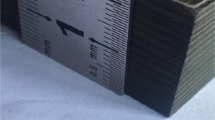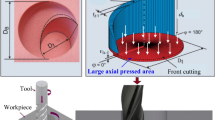Abstract
In order to significantly reduce the defects of hole-making on Carbon Fiber Reinforced Plastics (CFRP), a scheme on the variable parameter helical milling experiments was carried out. First, the helical milling process was analyzed. Second, using the response surface methodology (RSM) in the experiments, the max exit tear value, aperture diameter and surface roughness Ra at the intermediate area were analyzed and the optimum combination of parameters was obtained: spindle speed 8962 r/min, helical speed 60 r/min, and pitch 0.207 mm at the hole entry and exit areas; spindle speed 6242 r/min, helical speed 87 r/min, and pitch 0.205 mm at the hole intermediate area. Last, the effect of milling direction on hole-making was obtained: up milling at the hole entry and exit areas and down milling at the hole intermediate area. The superiority of variable parameter helical milling experiment was verified: there were fewer defects such as burrs and tears at hole entry and exit areas; and the surface roughness Ra was 6.39% lower, the aperture deviation was from + 0.011 mm to -0.007 mm at the hole intermediate area. Therefore, the quality of hole-making by the variable parameter helical milling scheme was significantly improved.























Similar content being viewed by others
Abbreviations
- N :
-
Spindle speed (r/min)
- n p :
-
Helical speed (r/min)
- a p :
-
Pitch (mm)
- e :
-
Eccentricity (mm)
- D :
-
Aperture (mm)
- d :
-
Diameter of tool (mm)
- Z :
-
The number of blade teeth
- Ra :
-
Roughness (μm)
- f :
-
Feeding speed (mm/min)
- ω 2 :
-
Revolution angular speed
- ω 1 :
-
Rotational angular speed
- S τ :
-
Feed per tooth
References
Ozkan D, Sabri Gok M, Oge M (2019) Milling Behavior Analysis of Carbon Fiber-Reinforced Polymer (CFRP) Composites. Mater Today: Proc. https://doi.org/10.1016/j.matpr.2019.01.024
Ishida T, Noma K, Kakinuma Y (2014) Helical Milling of Carbon Fiber Reinforced Plastics Using Ultrasonic Vibration and Liquid Nitrogen. Procedia CIRP. https://doi.org/10.1016/j.procir.2014.07.139
Uhlmann E, Schröer N (2015) Advances in Tool Grinding and Development of End Mills for Machining of Fibre Reinforced Plastics. Procedia CIRP. https://doi.org/10.1016/j.procir.2015.08.053
Shetty N, Shahabaz SM, Sharma SS (2017) A review on finite element method for machining of composite materials. Compos Struct. https://doi.org/10.1016/j.compstruct.2017.06.012
Tao C, Yujiang L, Yongsheng W (2021) Comparative study on cutting performance of conventional and ultrasonic-assisted bi-directional helical milling of CFRP. Int J Adv Manuf Technol. https://doi.org/10.1007/s00170-021-07418-3
Pereszlai C, Geier N (2020) Comparative analysis of wobble milling, helical milling and conventional drilling of CFRPs. Int J Adv Manuf Tech. https://doi.org/10.1007/s00170-019-04842-4
Wang BQ, Shi WJ, Zhao B (2022) A modal decomposition imaging algorithm for ultrasonic detection of delamination defects in carbon fiber composite plates using air-coupled Lamb waves. Measurement ARTN 111165 https://doi.org/10.1016/j.measurement.2022.111165
Wang F, Liu J, Liu L (2022) Quantitative non-destructive evaluation of CFRP delamination defect using laser induced chirp-pulsed radar photothermal tomography. Opt Lasers Eng. https://doi.org/10.1016/j.optlaseng.2021.106830
Cui JC, Liu W, Zhang Y (2022) A visual inspection method for delamination extraction and quantification of carbon fiber reinforced plastic (CFRP). Measurement. ARTN 111252 https://doi.org/10.1016/j.measurement.2022.111252
Yang GL, Dong ZG, Gao S (2020) A novel reverse helical milling process for reducing push-out delamination of CFRP. Composite Structures. ARTN 112778 https://doi.org/10.1016/j.compstruct.2020.112778
Wang F, Wang Y (2020) Influence of cryogenic cooling on milling hole exit of QFRP based on thermal–mechanical coupling. Int J Adv Manuf Technol. https://doi.org/10.1007/s00170-020-05916-4
Zhang S, Jiao F, Wang X (2021) Modeling of cutting forces in helical milling of unidirectional CFRP considering carbon fiber fracture. J Manuf Process. https://doi.org/10.1016/j.jmapro.2021.06.058
Amini S, Baraheni M, Hakimi E (2019) Enhancing dimensional accuracy and surface integrity by helical milling of carbon fiber reinforced polymers. Int J Light Mater Manuf. https://doi.org/10.1016/j.ijlmm.2019.03.001
Xu LH, Huang CZ, Niu JH (2021) Prediction of cutting power and surface quality, and optimization of cutting parameters using new inference system in high-speed milling process. Adv Manuf. https://doi.org/10.1007/s40436-020-00339-6
Abidi A, Ben Salem S, Yallese MA (2021) Machining quality of high speed helical milling of carbon fiber reinforced plastics. Proc Inst Mech Eng, Part C: J Mech Eng Sci. https://doi.org/10.1177/0954406221996736
Chen T, Wang CH, Xiang JP (2020) Study on tool wear mechanism and cutting performance in helical milling of CFRP with stepped bi-directional milling cutters. Int J Adv Manuf Tech. https://doi.org/10.1007/s00170-020-06305-7
Sheikh-Ahmad JY, Almaskari F, Hafeez F (2019) Thermal aspects in machining CFRPs: effect of cutter type and cutting parameters. Int J Adv Manuf Tech. https://doi.org/10.1007/s00170-018-2881-1
Li X, Jiao A, Xu M (2022) Study on Cutting Force and Surface Topography of Peripheral Milling CFRP. Exp Tech. https://doi.org/10.1007/s40799-022-00575-4
Li X, Jiao AY, Liu BH (2022) Study on helical hole-making process of CFRP/Al alloy laminated materials. Int J Adv Manuf Tech. https://doi.org/10.1007/s00170-022-09754-4
Li JP, Jiao AY, Chen XM (2021) Study on hole making process of thick-section CFRP. Int J Adv Manuf Tech. https://doi.org/10.1007/s00170-021-07929-z
Wang GD, Suntoo D, Li N (2018) Experimental research in CFRP/Ti stack through different helical milling strategies. Int J Adv Manuf Tech. https://doi.org/10.1007/s00170-018-2449-0
Banon F, Sambruno A, Fernandez-Vidal S (2019) One-Shot Drilling Analysis of Stack CFRP/UNS A92024 Bonding by Adhesive. Materials (Basel). https://doi.org/10.3390/ma12010160
Danesh Narooei K, Ramli R (2022) Optimal Selection of Cutting Parameters for Surface Roughness in Milling Machining of AA6061-T6. Int J Eng. https://doi.org/10.5829/ije.2022.35.06c.08
ArunRamnath R, Thyla PR (2022) Measurement and optimization of multi-attribute characteristics in milling epoxy granite composites using rsm and combined ahp-topsis. Surf Topogr-Metrol ARTN 025023 https://doi.org/10.1088/2051-672X/ac4566
Li X, Jiao A, Liu B (2022) Study on helical hole-making process of CFRP/Al alloy laminated materials. Int J Adv Manuf Technol. https://doi.org/10.1007/s00170-022-09754-4
Bayraktar S, Turgut Y (2020) Determination of delamination in drilling of carbon fiber reinforced carbon matrix composites/Al 6013-T651 stacks. Measurement ARTN 107493 https://doi.org/10.1016/j.measurement.2020.107493
Sivarao P, Rahim A, Taufik A (2007) In Proceedings of international conference on engineering and ICT, ICEI. 7:12–17
Ghidossi P, El Mansori M, Pierron F (2004) Edge machining effects on the failure of polymer matrix composite coupons. Compos A Appl Sci Manuf. https://doi.org/10.1016/j.compositesa.2004.01.015
Zhang L, Liu Z, Tian W (2015) Experimental studies on the performance of different structure tools in drilling CFRP/Al alloy stacks. Int J Adv Manuf Tech. https://doi.org/10.1007/s00170-015-6955-z
Hayajneh MT, Tahat MS, Bluhm J (2007) A study of the effects of machining parameters on the surface roughness in the end-milling process. Jordan J Mech Ind Eng
Xu JY, Mkaddem A, El Mansori M (2016) Recent advances in drilling hybrid FRP/Ti composite: A state-of-the-art review. Compos Struct. https://doi.org/10.1016/j.compstruct.2015.09.028
Khashaba UA, El-Sonbaty IA, Selmy AI (2010) Machinability analysis in drilling woven GFR/epoxy composites: Part II – Effect of drill wear. Compos A Appl Sci Manuf. https://doi.org/10.1016/j.compositesa.2010.04.011
Giasin K, Ayvar-Soberanis S, Hodzic A (2015) An experimental study on drilling of unidirectional GLARE fibre metal laminates. Compos Struct
Bolar G, Sridhar AK, Ranjan A (2022) Drilling and helical milling for hole making in multi-material carbon reinforced aluminum laminates. Int J Light Mater Manuf. https://doi.org/10.1016/j.ijlmm.2021.11.004
Ekici E, Motorcu A, Yıldırım E (2021) An experimental study on hole quality and different delamination approaches in the drilling of CARALL, a new FML composite. FME Trans. https://doi.org/10.5937/fme2104950E
Sridhar AK, Bolar G, Padmaraj NH (2022) Comprehensive experimental investigation on drilling multi-material carbon fiber reinforced aluminium laminates. J King Saud Univ-Eng Sci. https://doi.org/10.1016/j.jksues.2021.11.004
Boughdiri I, Giasin K, Mabrouki T (2021) Effect of cutting parameters on thrust force, torque, hole quality and dust generation during drilling of GLARE 2B laminates. Compos Struct. ARTN 113562 https://doi.org/10.1016/j.compstruct.2021.113562
Pawar OA, Gaikhe YS, Tewari A (2015) Analysis of hole quality in drilling GLARE fiber metal laminates. Compos Struct. https://doi.org/10.1016/j.compstruct.2014.12.056
Bonhin EP, David-Müzel S, Guidi ES (2021) Influence of drilling parameters on thrust force and burr on fiber metal laminate (Al 2024–T3/glass fiber reinforced epoxy). Procedia CIRP. https://doi.org/10.1016/j.procir.2021.02.035
Liu D, Tang Y, Cong WL (2012) A review of mechanical drilling for composite laminates. Compos Struct. https://doi.org/10.1016/j.compstruct.2011.11.024
Krishnaraj V, Prabukarthi A, Ramanathan A (2012) Optimization of machining parameters at high speed drilling of carbon fiber reinforced plastic (CFRP) laminates. Compos Part B-Eng. https://doi.org/10.1016/j.compositesb.2012.01.007
Sui SC, Song G, Sun C (2020) Experimental investigation on the performance of novel double cone integrated tool in one-shot drilling of metal stacks. Int J Adv Manuf Tech. https://doi.org/10.1007/s00170-020-05474-9
Mahdi A, Turki Y, Habak M (2020) Experimental study of thrust force and surface quality when drilling hybrid stacks. Int J Adv Manuf Technol. https://doi.org/10.1007/s00170-020-05252-7
Jia ZY, Zhang C, Wang FJ (2020) Multi-margin drill structure for improving hole quality and dimensional consistency in drilling Ti/CFRP stacks. J Mater Proc Technol. ARTN 116405 https://doi.org/10.1016/j.jmatprotec.2019.116405
Acknowledgements
This study was supported by the Fundamental Scientific Project of Education Department of Liaoning Province (LJKZ0295), Natural Science Foundation of Liaoning Province (2019-ZD-0029).
Author information
Authors and Affiliations
Contributions
Determine the research direction and list the outline: Anyuan Jiao; Study on the mechanism: Yue Zhang and Jianping Li; Experiment and data analysis: Yue Zhang and Jialong Zhang; original draft preparation: Yue Zhang.
Corresponding author
Ethics declarations
Conflict of Interest
The authors declare no conflict of interest.
Additional information
Publisher's Note
Springer Nature remains neutral with regard to jurisdictional claims in published maps and institutional affiliations.
Rights and permissions
Springer Nature or its licensor (e.g. a society or other partner) holds exclusive rights to this article under a publishing agreement with the author(s) or other rightsholder(s); author self-archiving of the accepted manuscript version of this article is solely governed by the terms of such publishing agreement and applicable law.
About this article
Cite this article
Jiao, A., Zhang, Y., Zhang, J. et al. Experimental Study of Helical Milling Carbon Fiber Reinforced Plastics by Variable Parameters. Exp Tech 48, 343–357 (2024). https://doi.org/10.1007/s40799-023-00665-x
Received:
Accepted:
Published:
Issue Date:
DOI: https://doi.org/10.1007/s40799-023-00665-x




